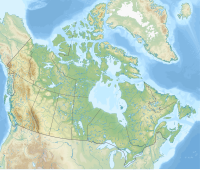Massive Mountain
Appearance
| Massive Mountain | |
|---|---|
 Massive Mountain | |
| Highest point | |
| Elevation | 2,435 m (7,989 ft)[1] |
| Prominence | 88 m (289 ft)[2] |
| Parent peak | Mount Brett |
| Listing | List of mountains of Alberta |
| Coordinates | 51°10′54″N 115°47′41″W / 51.18167°N 115.79472°W[3] |
| Geography | |
| Location | Alberta, Canada |
| Parent range | Massive Range Canadian Rockies |
| Topo map | NTS 82O/04 |

Massive Mountain is situated in Banff National Park, Alberta Canada. It is located in the Massive Range and was named in 1918 for its massive size.[1][2]It however is not the highest summit in the range, that belongs to Mount Brett (2,984 m (9,790 ft)).
Geology
The mountain is composed of sedimentary rock laid down during the Precambrian to Jurassic periods.[4] Formed in shallow seas, this sedimentary rock was pushed east and over the top of younger rock during the Laramide orogeny.[5]
Climate
Based on the Köppen climate classification, it is located in a subarctic climate with cold, snowy winters, and mild summers.[6] Temperatures can drop below -20 C with wind chill factors below -30 C.
References
- ^ a b "Massive Mountain". cdnrockiesdatabases.ca. Retrieved 2019-06-25.
- ^ a b "Massive Mountain". Bivouac.com. Retrieved 2019-06-25.
- ^ "Massive Mountain". Geographical Names Data Base. Natural Resources Canada. Retrieved 2019-06-25.
- ^ Belyea, Helen (1960). The Story of the Mountains in Banff National Park (PDF) (Report). Geological Survey of Canada. Archived (PDF) from the original on 2 October 2015. Retrieved 2019-06-23.
- ^ Gadd, Ben (2008). "Geology of the Rocky Mountains and Columbias".
{{cite web}}: Missing or empty|url=(help) - ^ Peel, M. C.; Finlayson, B. L.; McMahon, T. A. (2007). "Updated world map of the Köppen−Geiger climate classification". Hydrol. Earth Syst. Sci. 11: 1633–1644. ISSN 1027-5606.
{{cite journal}}: Unknown parameter|last-author-amp=ignored (|name-list-style=suggested) (help)
External links
 Media related to Massive Mountain at Wikimedia Commons
Media related to Massive Mountain at Wikimedia Commons- National Park Service web site: Banff National Park
- Massive Mountain weather: Mountain Forecast


